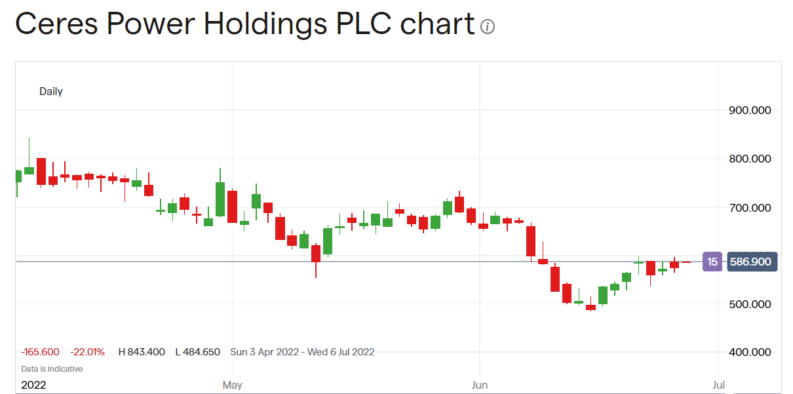Key points:
- Ceres Power has signed a deal with Shell to produce green hydrogen
- This is the other side of the fuel cell business, hydrogen production not consumption
- If it all works in economic terms then it's a major climate change contribution
Ceres Power Holdings (LON: CWR) shares suffer from a certain misunderstanding by the market in general. Which is that Ceres is thought to be in the energy generation business and this isn't quite so. At a certain level of logic Ceres is actually in the battery business – the energy storage at least – and it's possible to think that the correct valuation should be based upon that.
The technical background here is that Ceres Power works with a certain type of fuel cell, solid oxide fuel cells (SOFC). Most think of this as a cute way of gaining electricity when desired. Push hydrogen (or methane, methanol, ethanol, they can be tweaked to operate on many fuels) through an SOFC and gain electricity. This is the heart of how a Bloom Box, from Bloom Energy (NYSE: BE) works, for example.
But a more complete understanding of the basic technology tells us that SOFC tech is really a battery – that is, an energy storage system. Because if you run water and electricity through one (admittedly, with a tweak or two to deal with the reversed flow) then you get hydrogen. This is what Ceres calls SOEC, solid oxide electrolysis cell.

Also Read: How Does Inflation Affect The Stock Market?
What this means is that SOFCs (and SOECs, if we want to use that phrasing) can be used to work as a battery or power storage system. We gain electricity from the unreliables of wind and solar, convert that to hydrogen, now we've got dispatchable power which we can use any time by running the H2 back through an SOFC. It's also true that there are a number of industrial processes which can only be decarbonised – steel making, say, through DRI – if we've a source of green hydrogen. Further, if we've got cheap green hydrogen then the chemistry to manufacture synthetic methane, for example, is simple enough and we can all keep using gas heating and cooking.
Being able to get the whole cycle right, to be generating H2 from electricity, to using H2 to generate, means that we then do have a large scale storage system – a battery. We've thus solved a major climate change problem, the intermittency of renewables. This absolutely works in its engineering – it's whether it can be made to work in an economic sense which is the remaining issue.
Which is what interests about Ceres Power‘s tie up with Shell. They're to build an SOEC plant to work alongside Shell in India. To take renewable electricity and convert to hydrogen that can then be used in varied industrial processes – green hydrogen. Which is nice, but it's not the end of the process at all – viable and economic green hydrogen then opens up the SOEC/SOFC cycle to being that battery that we require for society more generally.
The issue here therefore becomes that Ceres Power is right at the cutting edge of a societally transformational technology, which is great. But then we've got the problem of whether Ceres will be able to dominate the industry and capture the value from it. Which is the real question which should determine any trading positions in Ceres.




